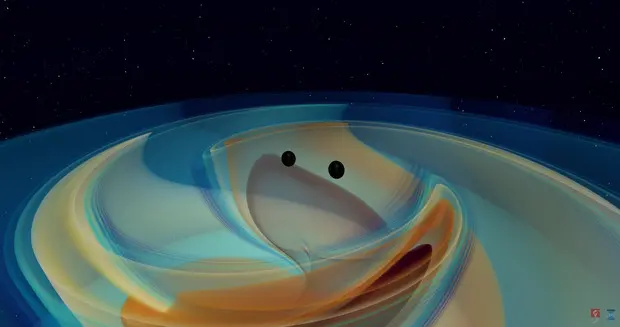The Pulteney Street SurveyWinter '24

This image is a still from a video of a numerical simulation of a heavy black-hole merger.
PHOTO COURTESY OF N. FISCHER, H. PFEIFFER, A. BUONANNO (MAX PLANCK INSTITUTE FOR GRAVITATIONAL PHYSICS), SIMULATING EXTREME SPACETIMES (SXS) COLLABORATION.
Astronomical Support
Black holes. Neutron stars. Binary systems. More than $1 million in grants from the National Science Foundation (NSF) will support the astrophysics work of Associate Professor of Physics Steve Penn as he develops tools to observe these stellar phenomena more clearly. Penn, who contributed to the Nobel-winning research that confirmed the existence of gravitational waves, has spent more than 25 years refining the sensitivity of the Laser Interferometer Gravitational-wave Observatory (LIGO) detectors. A new NSF grant supports Penn’s work to reduce thermal noise in LIGO’s mirror coatings and thereby increase what can be seen of the universe. Alongside this new funding, which will support student research opportunities, Penn received a continuation of a previous NSF grant to further develop mirror coatings.
99
Number of years elapsed between Albert Einstein’s prediction of gravitational waves in 1916 and their detection in 2015.
90+
Number of black holes and other such events that LIGO has detected since 2015 by observing gravitational waves, the ripples in the fabric of spacetime that Einstein predicted with his general theory of relativity.
100 Kilograms
Weight of new mirrors for LIGO’s next major upgrade. Penn’s research focuses on developing and characterizing crystalline mirror coatings, which will significantly increase the rate of gravitational waves detections and enable better observations of black holes, neutron stars and similar phenomena.
$108,714
Funds supporting a previous, continuing NSF grant. Over the next two years, this grant will support Penn’s development of mirror coatings to enhance the sensitivity of Cosmic Explorer, the proposed third generation gravitational wave detector.
25
Number of years that Penn has been part of the LIGO Scientific Collaboration (LSC), the international group of researchers focused on the direct detection of gravitational waves. HWS numbered among the first small colleges to join the LSC when Penn joined the faculty in 2002. He currently serves as Chair of the LSC Council.
2017
The year in which the LSC’s discovery of gravitational waves received the Nobel Prize in Physics. The prestigious and highly selective Special Breakthrough Prize in Fundamental Physics was also awarded to the global LSC research team, including Penn, among many other recognitions of their pioneering work.
10x
Factor by which the new crystalline mirror coatings could reduce thermal noise, allowing the detection of many more events at much higher sensitivity.
2
Number of LIGO observatories, one in Hanford Site, Wash., the other in Livingston, La.
$1,077,454
New grant funding from the NSF supporting a three-year project to refine the sensitivity of LIGO detectors.
